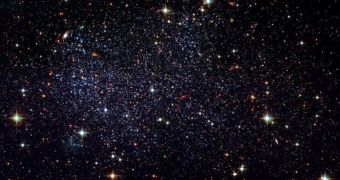Until recently, the widely held view on galactic formation and development was that these space structures tended to form from primordial building blocks. Experts thought that, in the billions of years that passed since the Universe first appeared, these blocs evolved on their own, and that making them out was impossible. But new scientific observations seem to contradict this idea. Experts observed primordial dwarf galaxies inside the halo of the larger galaxies they formed through mergers.
It would appear that one of the main factors responsible for the creation of early large galaxies is dark matter. Halos of the stuff acted through the force of gravity on numerous dwarf galaxies around them, pulling them in and forcing them to merge. This naturally resulted in the formation of larger galaxies, which appeared very early in the history of the Cosmos. In new studies, it was revealed that some of these massive galaxies still contained their dwarf building blocks inside their halos, in a state very similar to the one they were in when they first merged into the larger structure.
The findings hold especially true in the case of dwarf galaxies that contain numerous metal-poor stars, celestial bodies that accumulated a lot less of the heavy elements when they formed from their cosmic gas and dust cocoons. Recently, while looking into the Sculptor dwarf galaxy, experts discovered a metal-poor star that had only 0.00025% of the iron that our Sun had. If their find is confirmed, then it could mean that metal-poor, dwarf galaxies and metal-poor stars are linked to each other. This could provide an explanation for the large number of such stars still adorning the halos of massive galaxies.
The team behind the work emphasizes that the correlations are still fairly far-fetched, but not impossible. The group admits, however, that a lot more investigations into the matter are needed before correlations between metal-poor stars, their dwarf galaxies, and their massive counterparts can be drawn. “Future observational searches should discover more such objects in Sculptor and other dwarf galaxies,” the experts believe.
The work was conducted by scientist at the Harvard-Smithsonian Center for Astrophysics (CfA), the California Institute of Technology (Caltech), in Pasadena, and the Carnegie Institution of Washington. The 6.5-meter Magellan Telescope was used for the astronomical observations. The instrument is located at the Las Campanas Observatory, in Chile, Space Fellowship reports.

 14 DAY TRIAL //
14 DAY TRIAL //